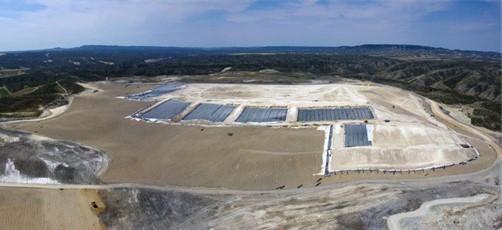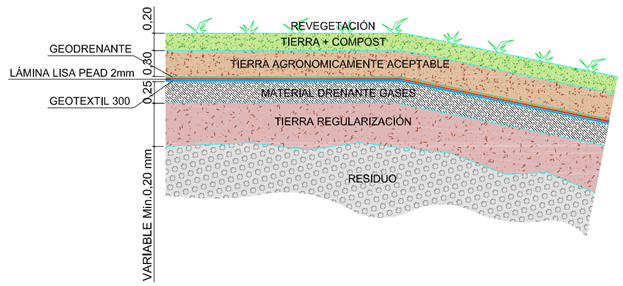The Waste Disposal Center of Zaragoza (C.E.R.) began its operation on November 1, 1987, being April 30, 2009 the last day of waste acceptance there. The C.E.R. covered urban, non-hazardous industrial and inert waste produced in the city of Zaragoza and surrounding areas.
The purpose of the Phase I project for the sealing and closure of the Waste Disposal Center consisted of the sealing and closure of the Urban Solid Waste Cell – Zone 1 and its landscape recovery in order to maintain the correct environmental condition of the Disposal Center.
Each of the different phases of the exploitation of Zone 1 consists of a 2 m thick layer of waste compacted with a padfoot compactor in order to reduce its volume and increase the stability of the landfill mass and a 0.2 m thick covering layer to obtain a homogeneous surface that provides adequate evacuation of rainwater runoff and also provides a stable base for the subsequent placement of the different elements that will make up the sealing layer of this area.
The works that make up Phase I are the waterproofing, the perimeter network for leachate collection and transport, the revegetation works, the rainwater runoff drainage works, the replacement of the electrical installation, the degasification infrastructure works and the environmental control and monitoring facilities.

Zone 1 waterproofing
In order to limit the formation of leachate due to infiltrated rainwater, the surface was waterproofed by means of the sealing package, placed on top of the regularization layer (from bottom to top):
- 0.25 m thick layer of drainage material for gases.
- Non-woven polypropylene geotextile 300 gr/m2 anti-puncture.
- HDPE sheet, 2.00 mm thick, smooth on platforms and textured on both sides on slopes with an inclination greater than or equal to 3H:1V, which constitutes the main barrier to leachate generation.
- Drainage geocomposite for rainwater drainage.
- Top layer of soil cover with a total thickness of 0.50 m., which will support the vegetation that will finally be planted.





